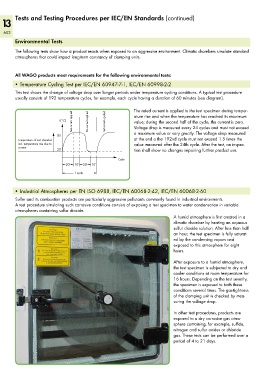Page 604 - Wago_PCB_TerminalBlocksConnectors_Volume2_2015_US
P. 604
13 Tests and Testing Procedures per IEC/EN Standards (continued)
602
Environmental Tests
The following tests show how a product reacts when exposed to an aggressive environment. Climatic chambers simulate standard
atmospheres that could impact long-term constancy of clamping units.
All WAGO products meet requirements for the following environmental tests:
• Temperature Cycling Test per IEC/EN 60947-7-1, IEC/EN 60998-2-2
This test shows the change of voltage drop over longer periods under temperature cycling conditions. A typical test procedure
usually consists of 192 temperature cycles, for example, each cycle having a duration of 60 minutes (see diagram).
The rated current is applied to the test specimen during temper-
Test current applied No current applied Test current applied value; during the second half of the cycle, the current is zero.
T (°C) ature rise and when the temperature has reached its maximum
Voltage drop is measured every 24 cycles and must not exceed
85 a maximum value or vary greatly. The voltage drop measured
Temperature of test chamber at the end o the 192nd cycle must not exceed 1.5 times the
incl. temperature rise due to value measured after the 24th cycle. After the test, an inspec-
current
20 tion shall show no changes impairing further product use.
Cycle
<20’> 10’ <20’> 10’
<_____ 1 cycle _____>
• Industrial Atmospheres per EN ISO 6988, IEC/EN 60068-2-42, IEC/EN 60068-2-60
Sulfur and its combustion products are particularly aggressive pollutants commonly found in industrial environments.
A test procedure simulating such corrosive conditions consists of exposing a test specimen to water condensation in variable
atmospheres containing sulfur dioxide.
A humid atmosphere is first created in a
climatic chamber by heating an aqueous
sulfur dioxide solution. After less than half
an hour, the test specimen is fully saturat-
ed by the condensing vapors and
exposed to this atmosphere for eight
hours.
After exposure to a humid atmosphere,
the test specimen is subjected to dry and
cooler conditions at room temperature for
16 hours. Depending on the test severity,
the specimen is exposed to both these
conditions several times. The gas-tightness
of the clamping unit is checked by mea-
suring the voltage drop.
In other test procedures, products are
exposed to a dry corrosive gas atmo-
sphere containing, for example, sulfide,
nitrogen and sulfur oxides or chloride
gas. These tests can be performed over a
period of 4 to 21 days.

